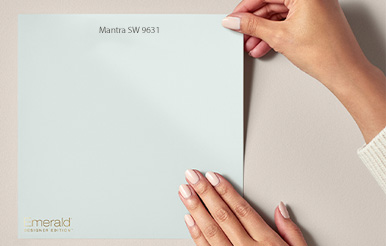Why Color Matters with Jackie
Color, it can express who you are and what you are feeling. Color attracts us to everything in life and is a critical decision to make while thinking of your home.
Video Transcription:
Color.
It attracts attention, changes moods, inspires creativity.
Color can express who you are and how you're feeling.
It's no wonder we so often like to ask people, “What's your favorite color?”
Look at the clothing in your closet.
Do you notice reoccurring colors?
What about the magazines you read?
Have you ever wondered what draws you to them?
Is it the content, the design, or both?
If you start thinking about what attracts you, you're likely to notice some consistency and the colors you prefer.
Color is a critical element in your life and it's certainly one of the most important decorating decisions you'll make in your home or workspace.
Paint color not only reflects your personal taste, it makes a statement about you.
The experts at your neighborhood Sherwin-Williams store are here to help you find your colors, the colors that will bring to life your unique vision.
Before getting started, ask yourself this question,
“What do I want to achieve with color?”
For instance, red stimulates appetite and conversation.
Green and blue are calming colors.
Yellow sparks creativity.
Orange is a strong vibrant color, the color spectrum equivalent to a double espresso.
Brown conveys stability and reliability.
It adds warmth and comfort to many settings.
White helps illuminate a space.
How you use color can also change the look of a space.
If you want a small space to seem open and airy, choose light colors.
Repetition of color will visually link spaces to create a sense of harmony.
Color can be used to highlight architectural features and define separate areas of your home.
A darker wall color can set off light colored objects within a room to create an instant focal point.
As you start selecting colors, keep these tips in mind.
When looking at a color strip, remember that deep accent colors may appear more intense on a wall and lighter colors may appear even lighter.
If you prefer a softer look with a hint of color, look at the top two colors of a color strip.
If you want to add more drama to a room, select colors from the center section.
If you want to create a bold statement, pick colors from the lower section of a color strip.
The color that you ultimately choose will be influenced by the light in your room.
So take color strips home or actually try a color on your wall with our color to go paint samples, to see how color looks during the day and at night.
You'll notice that incandescent or fluorescent lights have a different influence on color than natural daylight.
The type of paint finish you choose, flat, satin, or semi-gloss, may also affect how color interacts with light.
For example, a semi-gloss finish reflects more light, making a room brighter.
And to achieve a cohesive look in a room, limit the number of colors.
Be sure to consider all elements including flooring, furniture and accessories, along with paint color.
When you've had a chance to live with a color for a while, you'll easily discover if it delivers the look and feel you want.
Remember, decorating with color isn't a science.
There are no set rules.
Choosing color is a form of self-expression.
So whether it's playful or sophisticated, delicate or daring, restful or invigorating, color matters.









